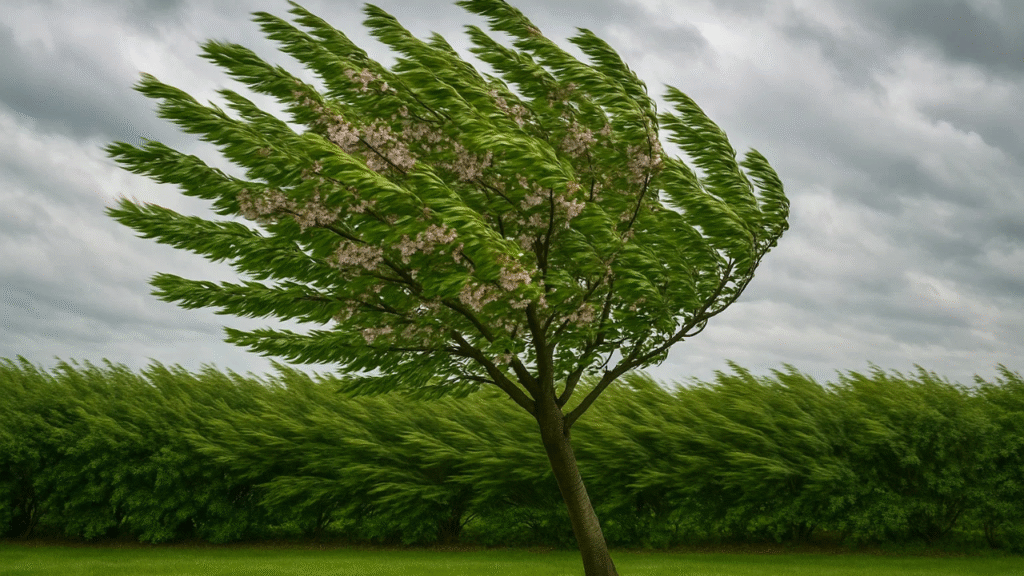
How to Protect Your Cherry Tree from Wind Damage: Essential Tips for Stronger Trees
Cherry trees are a beautiful addition to any garden, but they can be vulnerable to the harsh effects of strong winds. 🌬️ If you’ve ever watched your cherry tree bend and sway during a storm, you know the fear of seeing branches break or the tree itself become damaged. The good news is, there are simple and effective ways to protect your tree! In this guide, we’ll walk you through how to protect your cherry tree from wind damage and provide essential tips for strengthening your tree against the elements. 🌳 Whether you’re dealing with gusty winds or preparing for a stormy season, these strategies will help your cherry tree thrive, no matter the weather.
Table of Contents
Toggle🌬️🍒 Understanding Wind Damage to Cherry Trees 🍒🌬️
Wind damage is a serious concern for cherry trees, especially during storms or strong gusts. The impact of wind can be far-reaching, affecting both the tree’s structure and overall health. Here’s a breakdown of how wind can harm your cherry tree:

- Broken Branches: High winds can cause weak or unpruned branches to snap, which not only damages the tree but also creates open wounds that make it easier for pests and diseases to invade. 🌿💔
- Bark Damage: Strong winds can strip or tear away bark from the tree’s trunk, leaving it exposed to infections. This can eventually lead to rot if left untreated. 🪓⚠️
- Root Stress: Continuous exposure to wind can disturb the roots, especially if the tree isn’t well-established. Weak roots struggle to absorb water and nutrients, which can stunt growth and make the tree more susceptible to drought and disease. 🌱💧
- Fruit Loss: Wind can knock off delicate cherry fruits before they’re fully ripe, leading to a loss of potential harvest. It can also damage the fruit, making it less marketable or usable. 🍒🍃
How to protect your cherry tree from wind damage starts with recognizing the risks early. Recognizing the risks of wind damage helps you take early action to protect your cherry tree. By understanding the effects, you can better prepare and implement strategies to keep your tree safe and thriving.
🌪️🍒 How to Prepare Your Cherry Tree Before Windy Weather 🍒🌪️
Preparing your cherry tree ahead of time is the best way to minimize wind damage. Here’s how you can get your tree ready for strong winds:
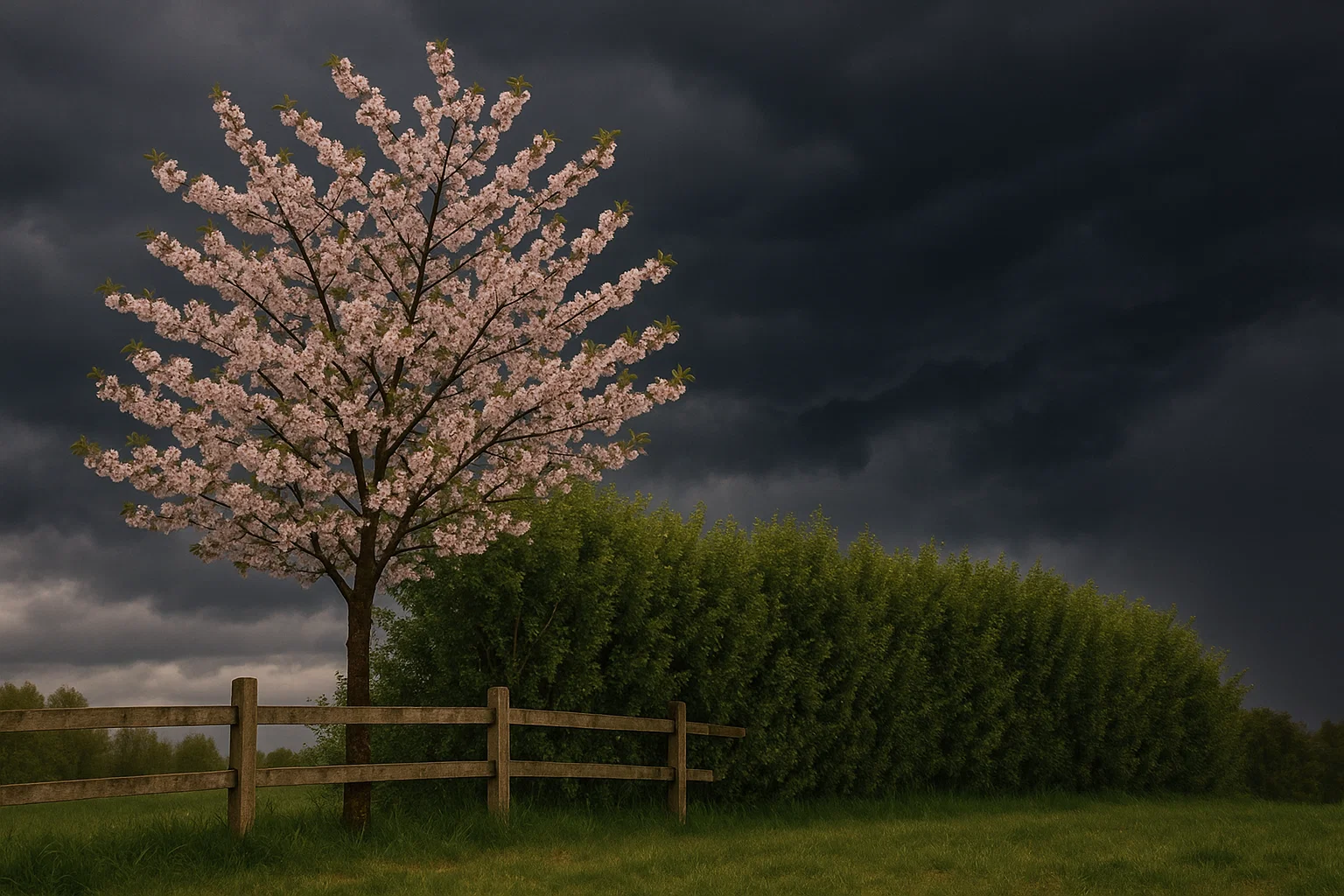
🌳🌿 Choose the Right Location
Plant your cherry tree in a spot that is naturally shielded from strong winds, such as near a fence, wall, or other tall plants. This provides some windbreak, reducing the direct force on your tree.
🌲🌾 Create Windbreaks
If your tree is exposed to strong winds, setting up a windbreak can protect it. Planting dense shrubs, erecting fences, or using temporary barriers like mesh netting around your tree can act as a shield. These will help block wind and prevent damage to the branches and trunk.
🌱🪢 Stake Young Trees
Newly planted cherry trees are especially vulnerable to wind. Staking the tree for extra support can prevent it from toppling or bending in strong winds. Use soft, adjustable ties to secure the tree to the stake, allowing for some movement as it grows. Be sure to remove the stakes after the tree becomes more established, as long-term staking can hinder growth.
🍂🪴 Mulch Around the Base
Adding a layer of mulch around the base of your tree helps retain moisture and stabilizes the soil, making the tree less likely to be uprooted by strong winds. Mulch also protects the root system from temperature fluctuations.
✂️🌿 Prune for Stronger Structure
Regular pruning is essential to remove weak, broken, or crossing branches. This not only improves the tree’s structure but also reduces the risk of branches snapping during windy conditions. Aim to prune in late winter or early spring, before the storm season hits.
Understanding how to protect your cherry tree from wind damage can make all the difference when harsh weather hits. By taking these steps before the windy season, you can help your cherry tree weather the storm and stay strong. 🏡🌳
✂️🍒 Proper Pruning to Prevent Wind Damage 🍒✂️
Pruning your cherry tree is one of the most effective ways to reduce the risk of wind damage. Here’s how proper pruning can help and what steps to take:
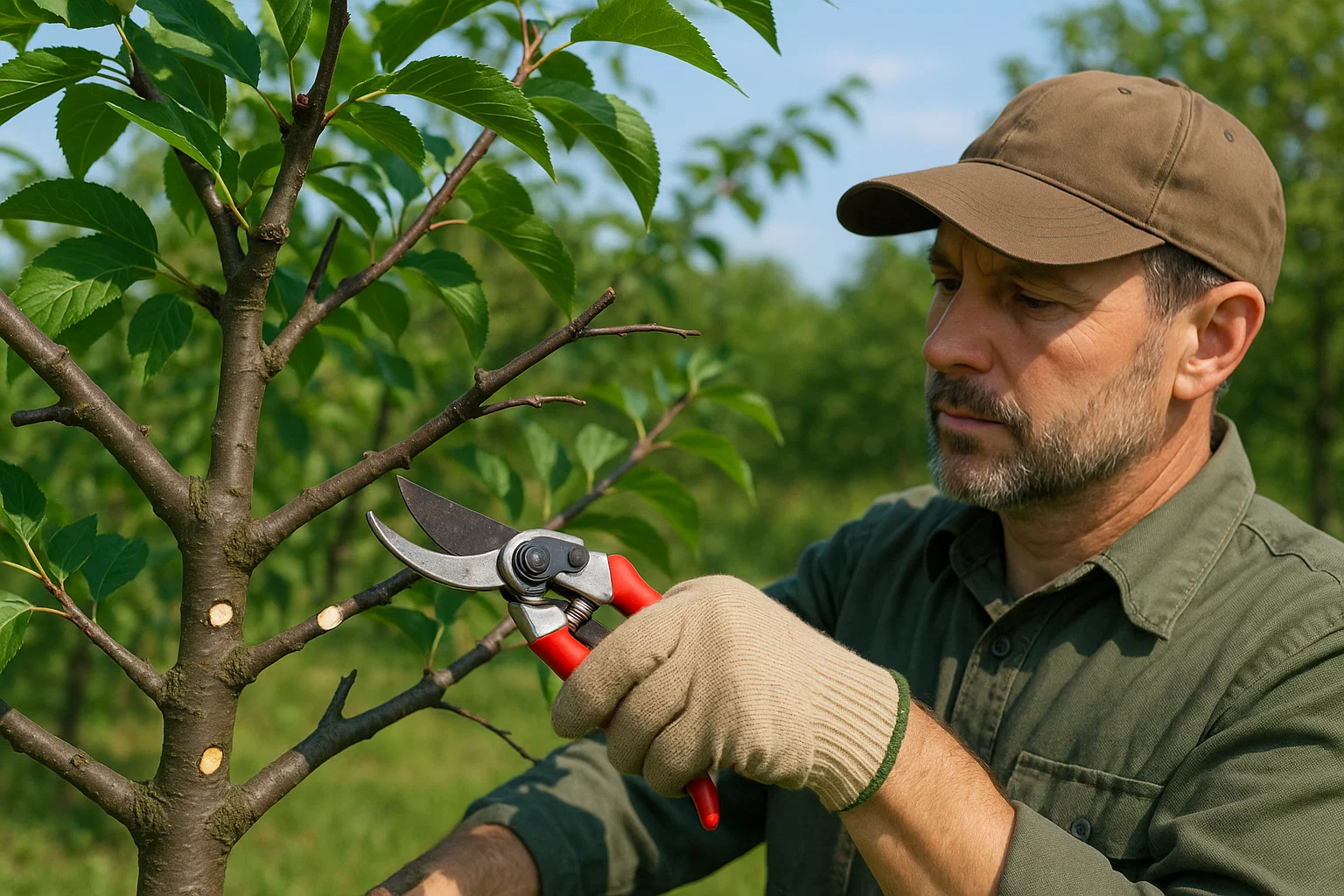
🌿💪 Why Pruning Matters 💪🌿
Pruning helps improve the tree’s structure by removing weak or damaged branches. This makes it less likely that branches will snap or break in strong winds. A well-pruned tree is also more balanced, which allows it to stand stronger against gusts.
🗓️✂️ When to Prune ✂️🗓️
The best time to prune your cherry tree is in late winter or early spring, before new growth begins. Pruning during this dormant period reduces stress on the tree and minimizes the risk of infection from pruning wounds.
🪓❌ Remove Weak or Broken Branches ❌🪓
Regularly check for any branches that are dead, weak, or broken. These are the first to snap under wind pressure. Removing them not only prevents damage but also encourages healthy growth and better air circulation within the canopy.
✂️➡️🌳 Eliminate Crossing Branches 🌳➡️✂️
Branches that cross each other can rub and weaken the bark, leading to potential breakage. By removing one of the branches in a crossing pair, you reduce the chance of damage during a storm and promote a more stable tree structure.
🌳🏆 Maintain a Strong Central Leader 🏆🌳
A “central leader” is the main vertical stem of the tree. This is the backbone of your cherry tree, and it should be the tallest, strongest part. Ensure that the central leader is well-pruned and unobstructed by competing branches, as it helps the tree resist wind by keeping a steady, upright posture.
By following these pruning practices, you’ll create a more resilient tree that can better withstand the forces of strong winds. 🌬️🍃
🌱💪 Strengthening the Root System 💪🌱
A healthy, strong root system is essential for your cherry tree’s stability and ability to withstand wind. Here’s how you can help strengthen your tree’s roots:
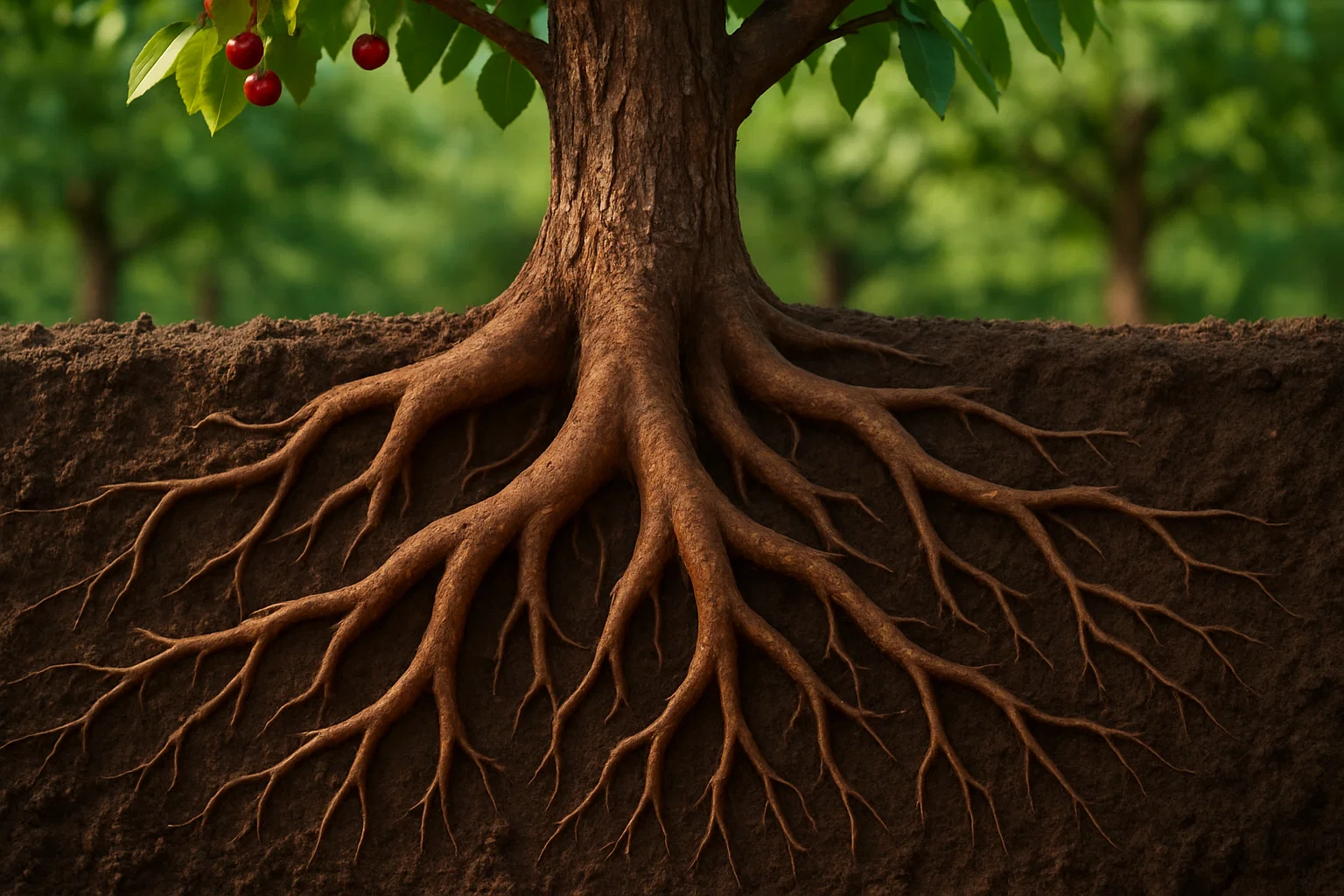
🌳 Healthy Roots = Stronger Tree 🌳
The roots are the anchor of your cherry tree, holding it firmly in place and absorbing the nutrients and water it needs to grow. A strong root system allows your tree to stand tall and resist being uprooted during high winds.
💧 Proper Watering 💧
Ensure your tree gets deep, consistent watering, especially during dry periods. Deep watering encourages roots to grow deeper into the soil, making them more resilient to wind stress. Avoid shallow watering, as it promotes surface roots, which are more vulnerable.
🍂🪴 Mulching 🪴🍂
Apply a layer of mulch around the base of your cherry tree. Mulch helps retain moisture, keeps the soil temperature stable, and prevents erosion. It also prevents root exposure to harsh winds and extreme temperatures, which can weaken the tree’s foundation.
⚖️🌱 Avoid Over-Fertilizing 🌱⚖️
While fertilization is important for tree health, over-fertilizing can cause excessive, weak growth that is more susceptible to wind damage. Use balanced fertilizers and apply them at the right times to avoid stressing the tree and its roots.
🌍💧 Soil Drainage 💧🌍
Ensure the soil around your cherry tree has good drainage. Waterlogged soil can lead to root rot and weak roots. If the soil doesn’t drain well, consider improving it by adding organic matter or planting on raised beds to keep the roots healthy and strong.
By focusing on root health, your cherry tree will be better equipped to withstand strong winds and thrive through tough conditions. 🌳🌪️
🛡️🍒 Using Protective Covers and Netting 🍒🛡️
Protective covers and netting are simple yet effective ways to shield your cherry tree from wind damage. Here’s how you can use them to keep your tree safe:
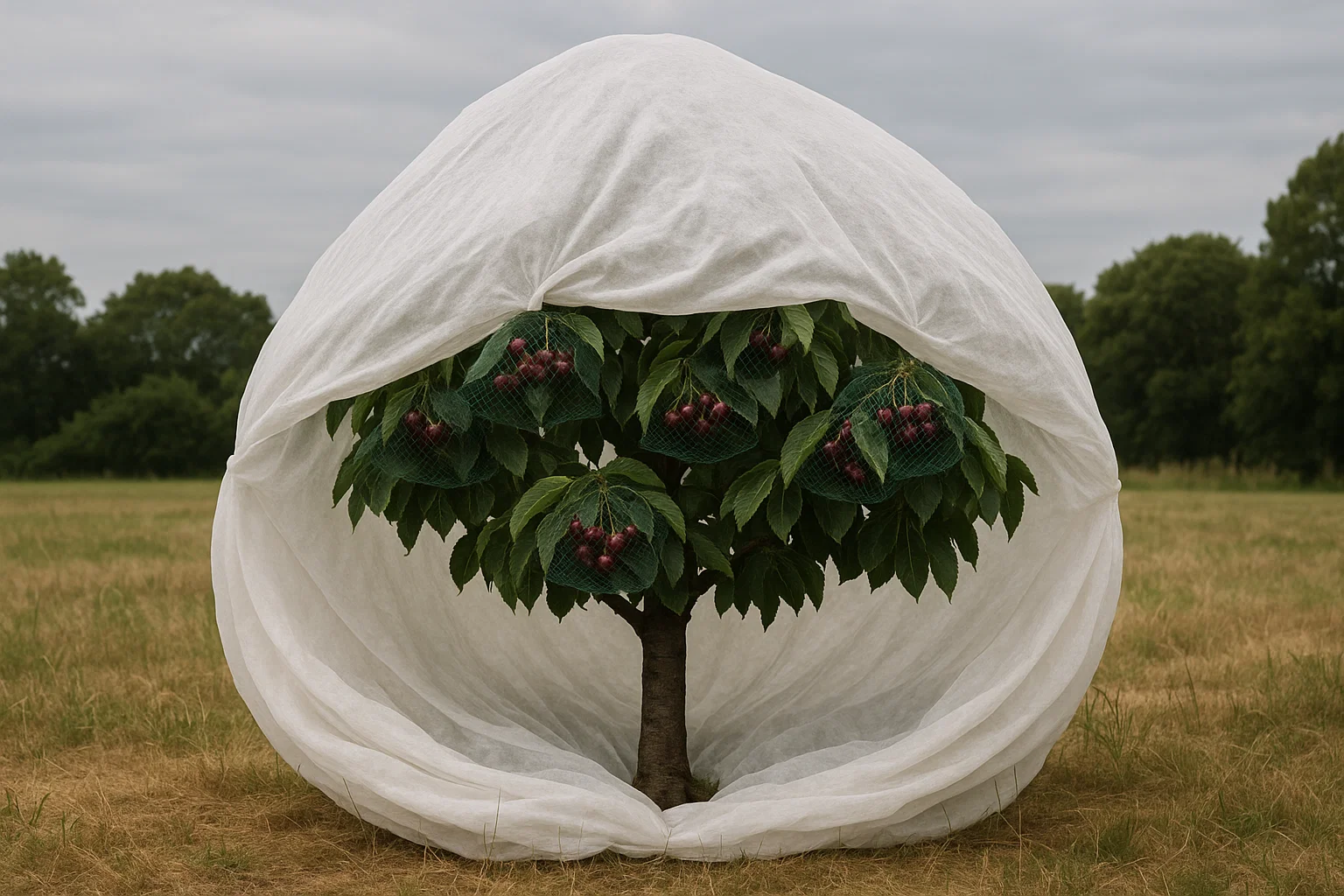
🌳🛑 Tree Covers for Extra Protection 🛑🌳
Using a protective cover, especially during extreme weather, can help shield your tree from both wind and frost. These covers act like a blanket, preventing the wind from directly hitting the branches and trunk. Make sure the cover is breathable to prevent moisture buildup, which can lead to mold or mildew.
🍒🧑🌾 Netting to Protect Fruit 🧑🌾🍒
Wind can knock cherries off the tree before they’re ready to harvest. Using netting around your cherry tree can keep the fruit in place while still allowing air to circulate. Lightweight, breathable netting won’t cause damage to the tree, but it will prevent fruit loss and reduce the risk of wind-induced bruising.
🌿🌬️ Temporary Wind Barriers 🌬️🌿
If you’re expecting a particularly windy season or storm, you can set up temporary wind barriers like mesh or fabric netting around the tree. These barriers act as windbreaks, diffusing strong gusts and reducing their force on the tree. Ensure that the netting is secured tightly, so it doesn’t fly away in the wind.
🌱💨 Protect Young Trees 💨🌱
For younger cherry trees, protective covers or netting are especially important. These smaller trees are more vulnerable to wind and can be easily damaged. Wrapping the tree in protective fabric or netting helps shield it until it becomes more established and stronger.
Learning how to protect your cherry tree from wind damage is the first step toward keeping it strong and thriving. Using these simple protective measures will give your cherry tree an extra layer of defense, helping it stay safe from wind damage and ensuring a healthier, more fruitful tree. 🍃🌪️
🌬️🔍 Identifying and Addressing Damage After Wind Storms 🔍🌬️
Even with the best precautions, windstorms can still cause damage to your cherry tree. Here’s how to identify and address any issues after a storm:
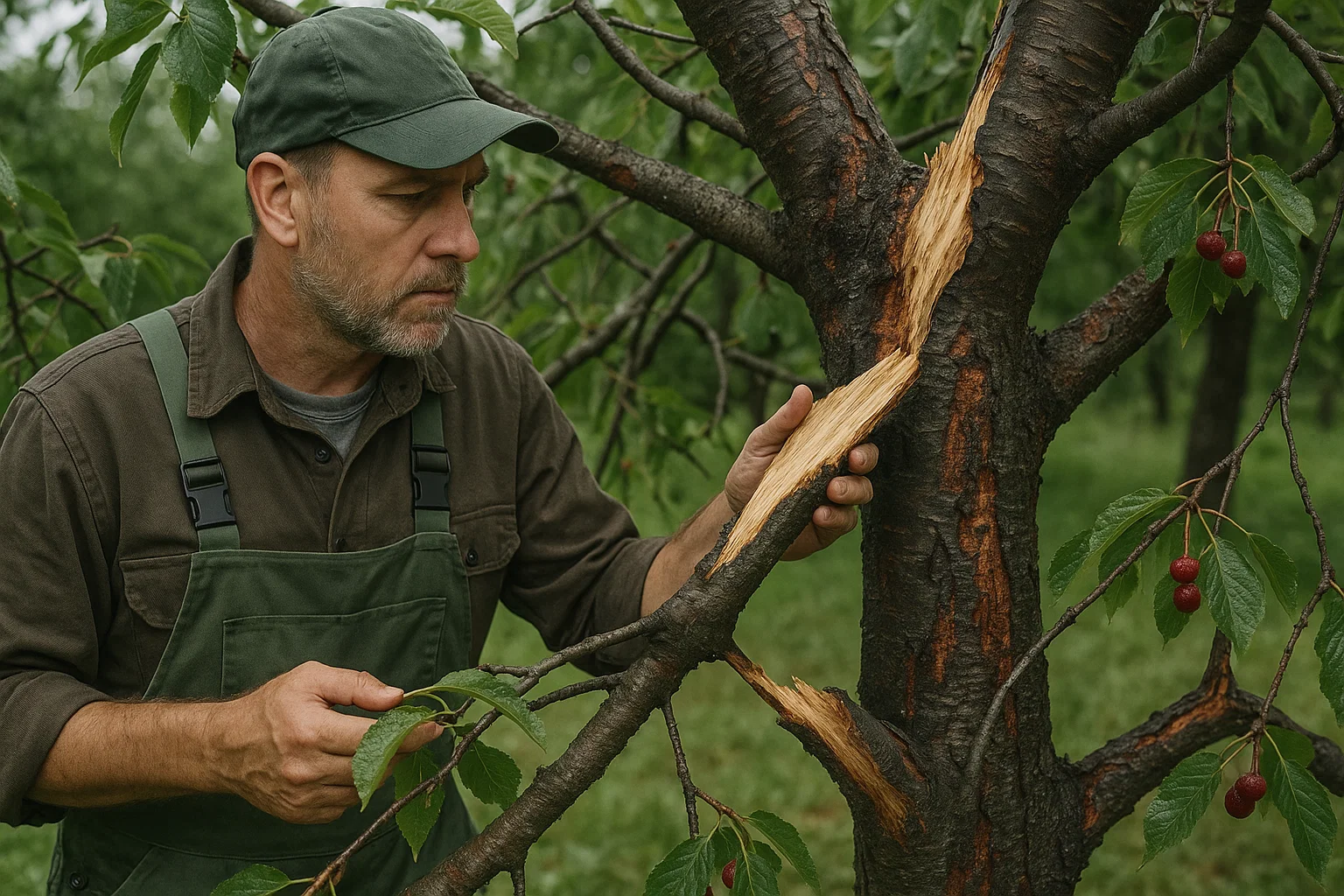
👀🍒 Post-Storm Inspection 🍒👀
After a windstorm, it’s essential to inspect your tree for any signs of damage. Look for broken or bent branches, torn bark, and fallen leaves or fruit. Pay close attention to the trunk and major limbs for cracks or splits, as these can indicate severe damage that may need attention.
🌱🛑 Check the Roots 🛑🌱
High winds can also disturb the root system, especially in young trees. Gently check around the base of the tree to see if the roots have been exposed or loosened. If you find any issues, backfill the soil carefully to secure the roots.
✂️❌ Trim Broken Branches ❌✂️
If you notice any broken or damaged branches, prune them back immediately. Use clean, sharp pruning tools to make cuts at an angle, just above a healthy bud or branch junction. This helps prevent infection and promotes proper healing. Never leave jagged, exposed edges, as they invite pests and diseases.
🩹🌿 Treat Damaged Areas 🌿🩹
For exposed or wounded areas, apply tree wound dressing or sealant to prevent infection. These products protect the tree from bacteria and fungi that can enter through the damage. If large areas of bark are stripped off, consider wrapping the tree with a protective cover until it heals.
🪴🛠️ Support Weakened Trees 🛠️🪴
If your tree’s trunk or branches have been bent or weakened by the wind, provide temporary support. You can stake the tree or tie it to a sturdy structure to keep it upright until it regains strength. Ensure that the ties aren’t too tight, as this can restrict growth.
📞🌳 Call a Professional 🌳📞
If the damage is severe, such as a split trunk or a toppled tree, it’s best to call an arborist or tree care professional. They can assess the damage and determine whether the tree needs to be removed or if it can be saved with professional care.
By promptly addressing any damage after a storm, you help your cherry tree recover faster and reduce the risk of long-term health issues. Regular inspections and quick action will ensure your tree remains strong and protected for future seasons. 🌿🌈
🌳💨 Long-Term Care for Cherry Trees in Windy Areas 💨🌳
To ensure your cherry tree stays strong and resilient against future windstorms, long-term care is essential. Here’s how to provide consistent care and keep your tree healthy in windy areas:
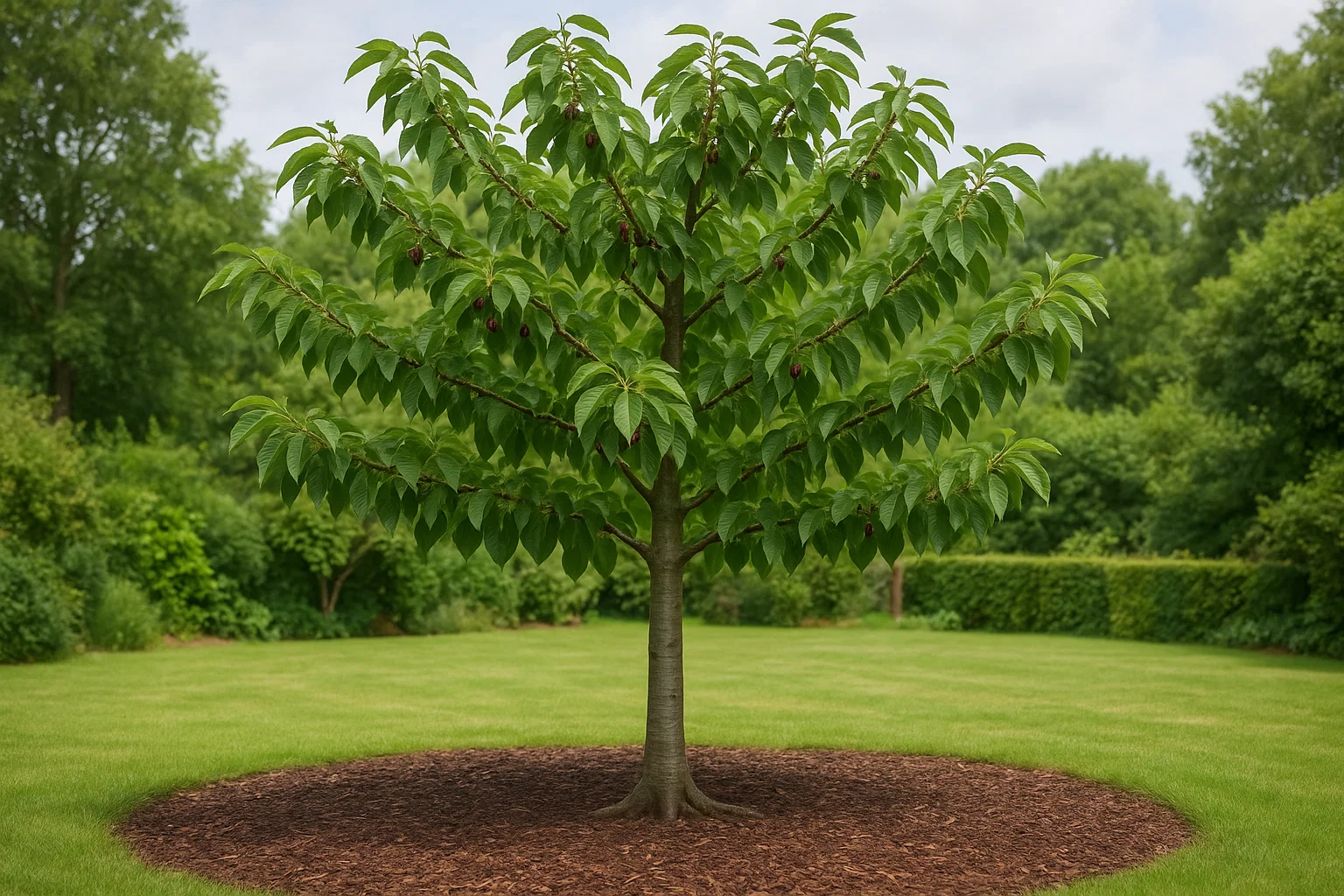
✂️🌿 Regular Pruning 🌿✂️
Continue to prune your cherry tree regularly to maintain its structure. Remove weak or dead branches, especially after storms, to prevent damage in future winds. Proper pruning also encourages stronger growth and helps the tree develop a balanced canopy that can better withstand gusty weather.
💧🍂 Mulch and Watering 🍂💧
Consistently mulch around the base of your tree to retain moisture, regulate temperature, and protect the roots. Water deeply, especially during dry periods, to encourage deep root growth, which will anchor the tree more firmly in the ground. Avoid shallow watering, as it can cause the roots to stay near the surface, making the tree more vulnerable.
🌱⚖️ Fertilize Wisely ⚖️🌱
Fertilizing your tree helps maintain its overall health, but be cautious not to over-fertilize. Excessive nutrients can lead to weak, fast-growing branches that are more susceptible to wind damage. Use balanced, slow-release fertilizers and apply them in early spring or late fall.
🌳🔩 Strengthen the Trunk and Roots 🔩🌳
Over time, you may need to further strengthen your tree’s trunk and root system. Install additional supports if necessary and ensure the tree is securely rooted in place. If the soil around the tree is poor or unstable, consider improving it with organic matter or aerating the soil to promote healthy root growth.
👀🌿 Monitor the Tree’s Health 🌿👀
Keep an eye on your cherry tree for any signs of stress or disease. If you notice unusual symptoms like wilting leaves, discoloration, or pests, address these issues promptly. Healthy trees are more resistant to wind damage, so regular monitoring is key to long-term success.
🌳💨 Consider Wind-Resistant Varieties 💨🌳
If you live in an area with frequent strong winds, you might want to consider planting more wind-resistant cherry tree varieties. Some types, like ‘Stella’ or ‘Montmorency,’ are more resilient to wind, though all cherry trees benefit from proper care and protection.
By providing ongoing care and attention, you can help your cherry tree thrive in windy conditions, ensuring it stays strong and healthy for many seasons to come. 🌿🍒
🌳🍒 Final Thoughts 🍒🌳
Protecting your cherry tree from wind damage requires a combination of proactive measures, proper care, and timely interventions. By understanding the risks, preparing your tree with windbreaks, pruning wisely, and strengthening the root system, you can greatly reduce the impact of strong winds. 🌬️
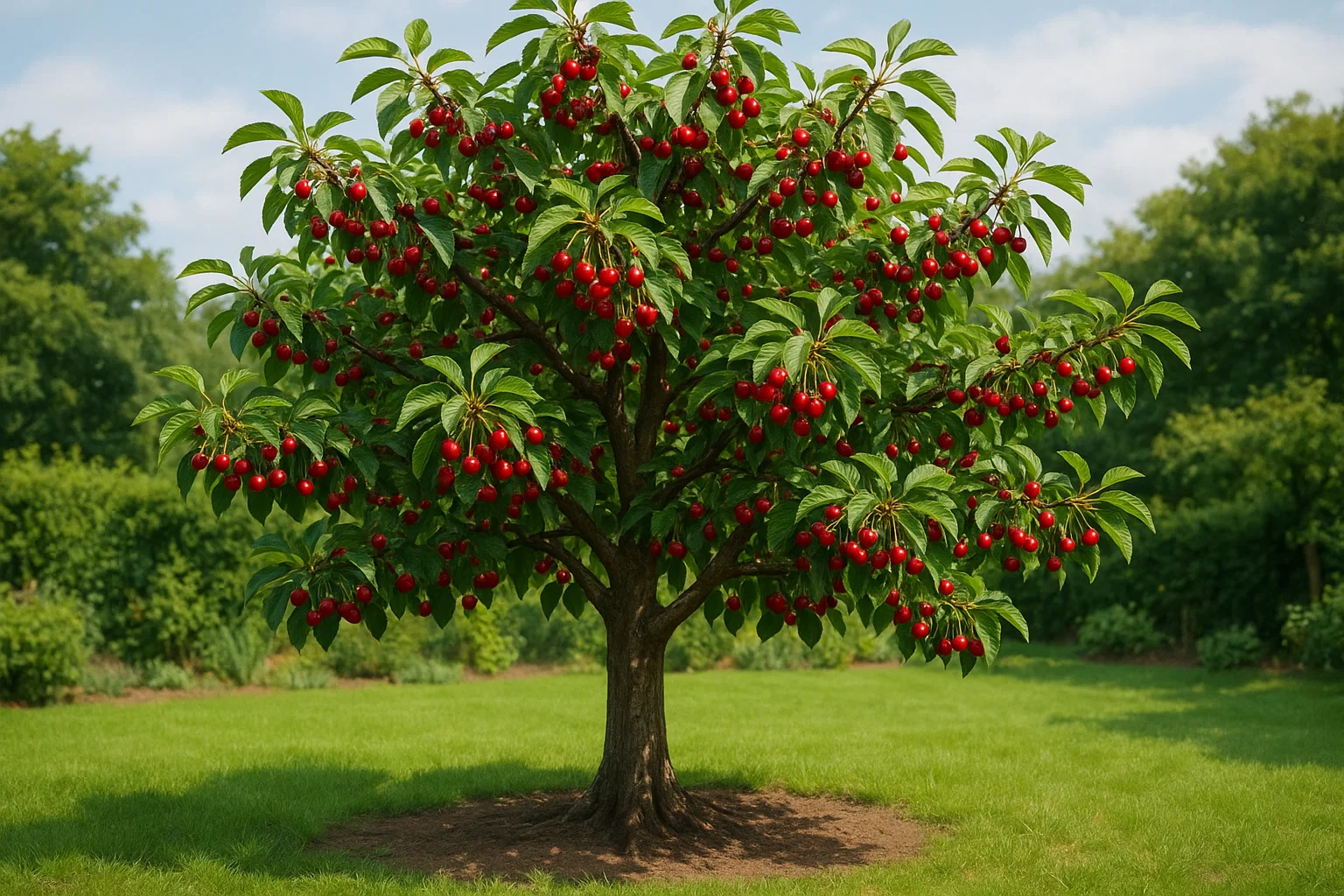
Remember, the key to a strong and resilient tree lies in long-term care: consistent watering, mulching, and regular pruning will keep your tree healthy and better able to withstand the elements. Knowing how to protect your cherry tree from wind damage is also crucial to prevent broken branches and long-term stress. 🌱
Whether you’re dealing with gusty winds or preparing for stormy seasons, following these essential tips will help you safeguard your cherry tree, ensuring it remains vibrant, fruitful, and strong for years to come. 🌿🍒
Take action today, and your tree will thank you with a bountiful harvest tomorrow! 🌸🍒
Frequently Asked Questions (FAQ)
Why is wind damage a concern for cherry trees?
Wind can cause branches to break, damage the bark, and weaken the tree, making it more susceptible to disease.
How can I protect my cherry tree from strong winds?
Using windbreaks, staking young trees, and proper pruning can help reduce wind damage to cherry trees.
When is the best time to protect my cherry tree from wind?
Before the storm season or during early spring, when the tree is still dormant, is the best time to prepare your tree.
Should I prune my cherry tree to reduce wind damage?
Yes, pruning can help by removing weak or damaged branches, improving the tree’s structure to withstand wind.
What types of windbreaks work best for cherry trees?
Fences, shrubs, or specially designed wind barriers can help protect your cherry tree from harsh winds.
Item #6aCan staking a cherry tree prevent wind damage?
Staking can provide support to young trees, preventing them from toppling or bending under strong winds.
How do I know if my cherry tree has suffered wind damage?
Look for broken branches, bark damage, or fallen leaves, which can indicate wind stress on the tree.
Are there any specific cherry tree varieties more resistant to wind damage?
Some cherry tree varieties, like the ‘Stella’ or ‘Montmorency,’ are naturally more resilient to wind, but all trees need proper care.
